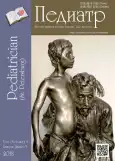Psychotic disorders of postpartum period as states of potential threat to newborn’s life and health (Clinical Case analysis)
- 作者: Kozhadey E.V.1, Grechanyi S.V.1
-
隶属关系:
- St. Petersburg State Pediatric Medical University
- 期: 卷 9, 编号 5 (2018)
- 页面: 109-114
- 栏目: Articles
- URL: https://ogarev-online.ru/pediatr/article/view/10824
- DOI: https://doi.org/10.17816/PED95109-114
- ID: 10824
如何引用文章
全文:
详细
This article describes clinical picture of postnatal psychoses. In literature devoted to women’s postpartum mental disorders there are three variants: postpartum syndrome of “parturient sadness” (postpartum “blues”), postpartum depression and postpartum psychosis. Also, such diseases as postpartum panic disorders, obsessive-compulsive disorders, posttraumatic stress and others may occur. Ethiology of postpartum mental disorders may differ. In psychiatric literature the beginning of endogenic processual disease (with further chronical lifetime course) is often connected with development of postpartum psychosis. However, there are a lot of mentions about a possible beginning of psychosis due to exogenous hazards – after tough and long delivery followed convulsions and fever (40 Celcius and above). Interrelation with hidden infanticide is carried out. Infanticide includes cases of unpurposed and purposed abandoning an infant in situations dangerous for its health and life. Risk of postpartum psychoses followed by infanticide significantly increases in case of first-line relatives’ suicides. Case of severe delirious psychotic disorder during patient’s postpartum period in SPbSPMU is given. Psychopathologic symptoms of disorder are discussed. Lack of interrelation between pathological feelings and patient's belonging to concrete religious denomination is emphasized. Nosology of the given clinical case is discussed. Well-timed diagnostics of postpartum psychotic states is practically relevant. Postpartum psychoses are states that need evaluation from different perspectives.
作者简介
Ekaterina Kozhadey
St. Petersburg State Pediatric Medical University
编辑信件的主要联系方式.
Email: ekaterinakozhadey@gmail.com
Clinical Resident, Department of Psychiatry and Narcology
俄罗斯联邦, Saint PetersburgSeverin Grechanyi
St. Petersburg State Pediatric Medical University
Email: svgrechany@mail.ru
MD, PhD, Dr Med Sci, Assistant Professor, Head, Department of Psychiatry and Narcology
俄罗斯联邦, Saint Petersburg参考
- Международная классификация болезней 10-го пересмотра. Классификация психических и поведенческих расстройств. Клиническое описание и указания по диагностике / Под ред. Ю.Л. Нуллера, С.Ю. Циркина. - СПб.: Адис, 1994. [Mezhdunarodnaya klassifikatsiya bolezney 10-go peresmotra. Klassifikatsiya psikhicheskikh i povedencheskikh rasstroystv. Klinicheskoe opisanie i ukazaniya po diagnostike. Ed by Y.L. Nuller, S.Y. Tsirkin. Saint Petersburg: Adis; 1994. (In Russ.)]
- Микиртумов Б.Е., Ильичев А.Б. Курс общей психопатологии. - М.: Сотис, 2008. [Mikirtumov BE, Il’ichev AB. Kurs obshchey psikhopatologii. Moscow: Sotis; 2008. (In Russ.)]
- Amon S, Putkonen H, Weizmann-Henelius G, et al. Potential predictors in neonaticide: the impact of the circumstances of pregnancy. Arch Womens Ment Health. 2012;15(3):167-174. doi: 10.1007/s00737-012-0268-0.
- Barr JA, Beck CT. Infanticide secrets: qualitative study on postpartum depression. Can Fam Physician. 2008;54(12):1716-1717.e1715.
- Brockington I. Postpartum psychiatric disorders. Lancet. 2004;363(9405):303-310. doi: 10.1016/s0140-6736(03)15390-1.
- Pichler WJ. Delayed Drug Hypersensitivity Reactions. Ann Intern Med. 2003;139(8):683. doi: 10.7326/0003-4819-139-8-200310210-00012.
- Brookman F, Nolan J. The dark figure of infanticide in England and Wales: complexities of diagnosis. J Interpers Violence. 2006;21(7):869-889. doi: 10.1177/0886260506288935.
- Chessick CA, Dimidjian S. Screening for bipolar disorder during pregnancy and the postpartum period. Arch Womens Ment Health. 2010;13(3):233-248. doi: 10.1007/s00737-010-0151-9.
- Helle N, Barkmann C, Bartz-Seel J, et al. Very low birth-weight as a risk factor for postpartum depression four to six weeks postbirth in mothers and fathers: Cross-sectional results from a controlled multicentre cohort study. J Affect Disord. 2015;180:154-161. doi: 10.1016/j.jad.2015.04.001.
- Mehler K, Mainusch A, Hucklenbruch-Rother E, et al. Increased rate of parental postpartum depression and traumatization in moderate and late preterm infants is independent of the infant’s motor repertoire. Early Hum Dev. 2014;90(12):797-801. doi: 10.1016/j.earlhumdev.2014.09.008.
- Robertson E, Grace S, Wallington T, Stewart DE. Antenatal risk factors for postpartum depression: a synthesis of recent literature. Gen Hosp Psychiatry. 2004;26(4):289-295. doi: 10.1016/j.genhosppsych.2004.02.006.
- Stewart DE, Robertson E, Dennis CL, et al. Postpartum depression: literature review of risk Factors and interventions. Toronto; 2003.
- Thurgood S, Avery DM, Williamson L. Postpartum depression (PPD). Am J Clin Med. 2009;6(2):17-22.
补充文件







